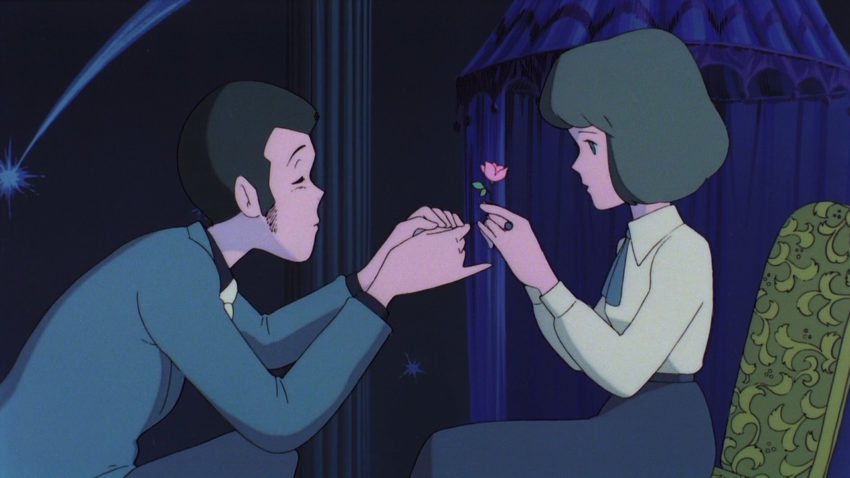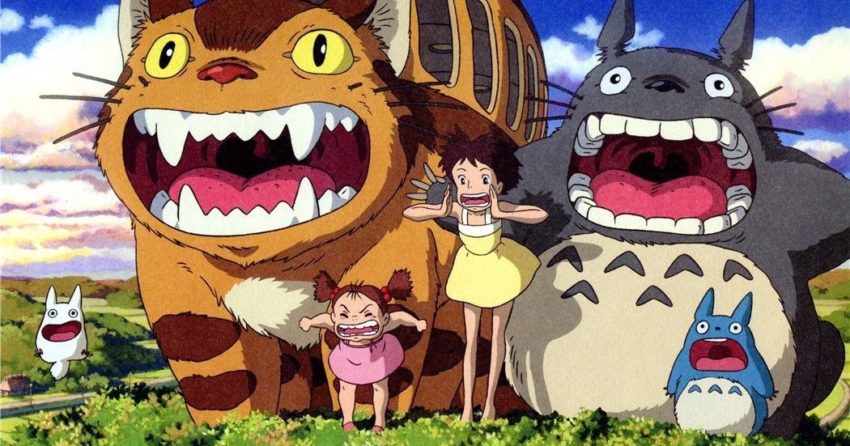Books: The Works of Hayao Miyazaki
February 27, 2021 · 0 comments
By Shelley Pallis.

In an already crowded field of critical appraisals of Ghibli films, the Toulouse-based Third Editions offer their latest English-language publication, Gael Berton’s The Works of Hayao Miyazaki: The Japanese Animation Master. It’s a beautifully designed book, on posh paper with a pretty cover, although one immediately wonders whether the world really needs another film-by-film run-through. It’s been 22 years since Helen McCarthy’s Hayao Miyazaki: Master of Japanese Animation first appeared; and more recently we’ve seen Raz Greenberg’s account of early Miyazaki, and Susan Napier’s magisterial career overview, not to mention the publication of Miyazaki’s own journalism in two volumes, Steve Alpert’s tell-all memoir, and a slew of other books, including individual monographs on Spirited Away and Kiki’s Delivery Service (coming soon). And that’s just in English – the French have even got a bloody Ghibli cookbook!
There is, in fact, an overwhelming amount of material already available, which means new authors, particularly of pricey hardbacks, should really make sure they have something to say on a topic that not only risks becoming hackneyed, but is already littered with far too many slipshod works. There is a vast archive of interesting material still waiting to be mined in Japanese, although to be fair, the majority of the also-rans, cash-ins and wastes of time are also in Miyazaki’s native language.

Berton’s opening account of Miyazaki’s life is an uncritical list of Some Things That Happened, without agency, conflict or motive. But that’s all fine – this is a book about the “works” of Hayao Miyazaki, so one can overlook an introduction that rushes to get to them. Unlike a couple of reviewers on Amazon UK, who dismiss the book out-of-hand because it has no illustrations, I am also perfectly happy with a publication on anime that doesn’t have pictures in it. Nevertheless, devoid of proper citations or critical touchstones, Berton has little to offer the reader but his own opinions. He starts off well with a visit to the Ghibli Museum, not only getting to flex his day-job muscles as a travel agent, but also leading with those works of Miyazaki that one has to literally make a pilgrimage to see – the short films exclusively on show in the museum cinema. He has, however, nothing to say about them beyond plot synopses.
Berton goes on to begin in earnest, not with Miyazaki’s first film as director, but with his first film as a leading animator, Isao Takahata’s Horus, Prince of the Sun. Here, he seems to have strong and persuasive materials about some of the political wrangles behind the scenes, noting inspirations that derive from the plight of Japan’s indigenous Ainu people and the experience of the US Occupation, although his understanding of the broader issues is, if not poor, then at least poorly worded. I don’t think the English version is to blame for any of this – it faithfully translates Berton’s comments, including one that seems to imply that the US Occupation, which ended in 1952, somehow stretched on for more than a decade. As ever, I can see where Berton is trying to go with this – he wants to make the point that American bases remain an enduring presence, and hence a reminder to the Japanese of the war and the surrender, but he really should have been clearer.

Each subsequent Miyazaki film gets a little chapter, usually comprising half a dozen pages, although since one of them has to be a plot summary, there is little space for Berton to do much more than make a couple of observations. He treats each film as a development of themes that Miyazaki would repeat in later productions, such as Lupin’s paternalistic behaviour towards Clarisse in Castle of Cagliostro, as a precursor to the relationship in Porco Rosso, or the foreshadowing of My Neighbour Totoro that can be perceived in Panda Go Panda. He makes a good point that Clarisse in Cagliostro addresses Lupin as Dorobo-san (“Mr Thief”), “dampening the pejorative element of his profession to place him on a sympathetic footing,” but such insights are rare.
Berton has more to say on Porco Rosso, plunging deep into the idiosyncrasies of the Japanese script, although comparing it for some reason with the English dub – was this a fix swapped in for an English edition, or was he cribbing from an English source? Or possibly two sources, since his comments confuse the casts of the JAL and Disney releases. I am also a bit befuddled myself as to how Berton can suddenly know enough Japanese for a few paragraphs to quote chapter and verse from the original, but not be similarly erudite for the other 200 pages.

His developing theme approach does get some nice pay-offs, particularly in a chapter that argues for Princess Mononoke as a flawed and despondent reimagining of the themes of Nausicaa of the Valley of the Wind. In a rare moment of critical assertion, Berton rejects the idea that Princess Mononoke is an environmental fable, suggesting instead it is an allegory of the extreme difficulty that mankind faces in living in harmony with nature. Well, yes, okay, but that would still mean it was an environmental fable!
There are several space-filling biographies of Miyazaki’s associates, each hammered into a glib assessment like “the official composer” (Jo Hisaishi) or “the riled spiritual successor” (Mamoru Hosoda). Hiromasa Yonebayashi is described, somewhat unfairly, as a “disappointing protégé.” My issue here is not with Berton’s assessment of Yonebayashi’s films, which are indeed rather soulless clones of Ghibli’s heyday, but with his assumption that such mimicry wasn’t the idea all along (as Berton notes himself, Mamoru Hosoda left for a reason), and secondly that Yonebayashi was the protégé. Long-term Ghibli watchers will know, of course, that it would have been far better to consider Yoshifumi Kondo as Miyazaki’s intended heir, although he “disappointed” everybody by dropping dead after completing Whisper of the Heart. Berton includes an entry on Kondo as the “would-be successor,” but does not stop to consider if his early death might have been a substantial contributor to the “disappointing” nature of Yonebayashi’s appointment. In his meandering conclusion, he does note that even conceiving of a successor to such a unique visionary like Miyazaki is “reductive”… so why did he bother doing so earlier!?
Another author might also have devoted some time to Toshio Suzuki’s late-Ghibli apprentice scheme, in which several animators were handpicked to shadow Miyazaki at work, several of whom have gone on to great things. Or, perhaps, Berton could have noted that far from being a “faithful friend” as he is labelled here, Evangelion’s Hideaki Anno might have equally been described as a “disappointing protégé.” Berton doesn’t wonder who might be disappointed, and what they might be disappointed by – there are multiple avenues to explore in such a question, but he does not delve past his snappy headlines.
Mrs Miyazaki is “a very private person,” we are told, about the woman who wrote an entire book about raising the Miyazaki children. Miyazaki “has never spoken” about his father’s death, we are told, even though Berton has already quoted an article he wrote on that subject in a national newspaper. The book is full of such gaffes – not errors as such, but frustrating and distracting fudges that really should have been sanded away by the editor of the original edition. Berton also often seems wrong-footed by the temporality of his sources – an account of Studio Ghibli’s hiring practices is in the present tense, as if the place were not shuttered after whatever interview or article provided his material, and resurrected under very different conditions a couple of years later.

Berton claims that Totoro only found true popularity in the 1990s when it began to show up on television. That’s an interesting assertion, albeit one that rather ignores the massive sales it enjoyed on video. And there’s no citation, so I have no idea if he’s just making that up, anyway. The Totoro theme song is apparently an “anthem for kindergartens” all over Japan. What, officially? Compulsorily? Is it something he once heard at a day-care centre, or something he read in a newspaper? There are no citations, so I am none the wiser.
Berton’s bibliography, in fact, is worryingly patchy – it would be gauche to expect a French author, working in French for a French readership to wade too deeply into Anglophone material, but it wouldn’t have killed him to acknowledge the works of, say, Napier and McCarthy – not doing so merely makes him look like a man who has not put in the necessary legwork, or who has ignored McCarthy’s pioneering interviews and Napier’s extensive quoting of Japanese-language sources. For all I know, English-language materials may have supplied a great number of the unsourced quotes that pepper the book, but it is impossible to tell. Some of his “explanations” have a cornflake-packet superficiality that suggest he has gone no further than Wikipedia. Nor has he bothered to investigate visual media – there is an entire film, for example, Never-Ending Man about late-period Miyazaki, but it is not mentioned here.
In fact, Berton confesses in his introduction that his Miyazaki musings had their beginnings on a French-language website, which wholly explains why they feel like a bunch of punchy featurettes. I might glance at his writings for free online, but are they really worth £23 in hardback? Amazon might be his (and your) saviour, there, since when I was just checking the price for this article, I see it is currently available for under £15.
The Works of Hayao Miyazaki: The Japanese Animation Master is published in English by Third Editions.
anime, books, Gael berton, Hayao Miyazaki, Japan, Shelley Pallis, Studio Ghibli, Third Editions
Leave a Reply